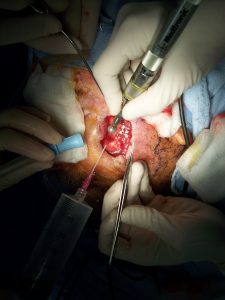Collaboration with specialists in other fields can improve outcomes for patients with skin cancer, and it can be personally and professionally rewarding for the dermatologist, according to Paul H. Bowman, M.D.
Speaking at the annual meeting of the American Academy of Dermatology, Dr. Bowman shared the perspective of a community-based private practitioner.
Describing his personal experience, he refuted concerns that prevent dermatologists from collaborating and provided some insights into making a collaboration operational.
“Concerns about not being ‘expert enough’ to collaborate with other specialists, losing patients through referral, or taking on added liability are some of the reasons that make dermatologists reluctant to become involved in a multidisciplinary team approach to treating difficult skin cancers. In reality, developing these collaborations does just the opposite,” says Dr. Bowman, a solo practitioner and fellowship-trained Mohs surgeon in Tampa, Fla.
“Because of our medical and procedural therapeutic skills, and our clinical and pathologic perspective, we as dermatologists are naturally and uniquely positioned to interact with and bring together specialists from other fields. In addition, working with other specialists is a good practice builder. Not only are you likely to see new patients who are sent by other physicians in the team, but by establishing a reputation as a dermatologist who works with other specialists, you get word-of-mouth referrals from doctors outside your team and from patients who recognize your office as a place where the buck stops, so to speak. Furthermore, getting other specialists involved early, before problems occur, is good risk management.”
Dr. Bowman also cites the benefits that come from interacting with other physicians as part of a collaborative team: Exposure to new ways of doing things expands your skill set with new techniques. Seeing what others do may confirm your existing approaches. Interacting with other physicians can mitigate feelings of isolation and provide intellectual stimulation, he says.
EXPANDED OPTIONS
Dr. Bowman notes that because of his fellowship training as a Mohs surgeon, he tends to see patients with more complicated skin cancers, who often need multidisciplinary care. Therefore, soon after he launched his career as a solo practitioner 13 years ago, he began to develop a network of colleagues able to provide input and services for his patients’ diverse needs.
Now he leads a multidisciplinary team that includes radiation, medical and surgical oncologists, as well as plastic, ENT and oculoplastic surgeons; ophthalmologists; internists; and wound-care specialists.
“Patients who require postoperative adjuvant radiation can work with the radiation oncologist, while the medical oncologist can help with the systemic work-up of patients with high-risk tumors using imaging, laboratory tests, and ongoing surveillance. Plastic surgeons can be helpful with very large, complicated repairs, as can oculoplastic surgeons when surgical defects involve the lacrimal system of the eyelid or deeper structures within the orbit,” Dr. Bowman explains.
“I get the otolaryngologist involved when a tumor extends into bone or parotid, and the surgical oncologist when sentinel lymph-node biopsy or further en bloc excision should be considered. A wound-care specialist can be invaluable in helping to manage large and complex wounds, while a good internist can help to treat perioperative medical issues such as hypertension or provide a good workup when there is concern about internal malignancy or an associated syndrome.”

Dr. Bowman works with an ENT colleague to burr out some involved bone to manage a positive bony margin. Photo: Paul H. Bowman, M.D.
GETTING STARTED
Not everyone wants to assume the role of team leader, but he encourages colleagues to become involved as participants in a multidisciplinary team for managing patients with skin cancer.
“If you do not want to be the coordinator, you can still reach out to other specialists and let them know what you can do as part of a team,” Dr. Bowman says.
Dermatologists who are surgically oriented may choose to focus on primary treatment of the tumor, risk stratification, and determination of the patient’s need for further care and surveillance.
Dermatologists who are not surgically oriented can also contribute to a multidisciplinary team through follow-up skin checks or evaluation of patients for cutaneous manifestations, side effects of radiation, or reactions to oncology medications.
BUILDING A TEAM
For dermatologists planning to develop or join a multidisciplinary team, it is important to review the skill sets of the other physicians, “because the care they provide reflects on you.” Consideration should also be given to each physician’s attitudes and philosophy about collaboration.
“Their desire to be part of a team should be driven by the idea that it will serve patients’ best interests and not because they see it as a good marketing tool for their practice. In addition, they should recognize that there is value in what you and other members of the team do,” he says.
Dr. Bowman also advises patience when building a team. “If it was easy to become involved in a collaborative team for managing patients with skin cancer, then all dermatologists would do it. Instead, it takes time to develop a network and to find the right group of collaborators. Speaking from experience, however, it is time well spent.”

